Antique Pottery From Asian Ship Wrecks
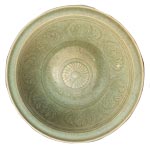


Antique Pottery From Asian Ship Wrecks |
   |
Earthen ware
|
Earthenware is the earliest type of pottery known to have existed for 10.000 years. Secondary clay was formed on the wheel or rolled into strings, laid on top of another to form the pot. Earthenware was commonly fired in simple open pits and therefore found in most of our old civilizations. Firing temperatures normally reached 400 to 700 degrees Centigrade but some types are known to have been fired at higher temperatures. Decorations were often limited to cord marks, made by pressing a cord into the wet clay. Elaborate cord patterns was similar in many countries and over wide areas and therefore difficult to assign to a specific place.
Most
of the earthenware found on the 14 - 16th century shipwrecks usually contain
some remnants of food or other on board necessities. Their limited number suggests that
earthenware was never made for export. |
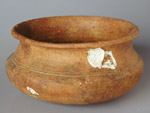 |
|
|
15 Century Celadon Ware
|
Celadon is a western word used originally to describe the green glaze
of ceramics from Longquan in China. An ash glaze (made of clay mixed with
wood ash), it requires 2-5% iron, and must be fired in a reduction
atmosphere.
A green glaze was in use in China by the 7th century, and during the Song dynasty (960-1280) this developed to a jade-like substance. Celadon, like jade, was believed to have magical and protective powers. It was said that celadon would ring if danger was approaching, and would change color to warn of poisoned food. No wonder it became so popular. Celadon technique was arguably perfected by the 12th and 13th century, when it depended solely on balanced form. By the 14th century, motifs such as lotus flowers and stylized chrysanthemums were incised for decoration. From the early-14th century, blue-and-white porcelain was introduced, and gradually displaced the underglaze black tradition.
Celadon production in Thailand seems to have started in the later
part of the 14th century - around the time of the 'Ming ban' of 1371
when emperor Hongwu prohibited the Chinese from continued overseas
trade. Many similarities support our contention that this was no
coincidence, and that Chinese migrants were responsible for the same.
Chinese celadon was found on the Turiang and Longquan shipwrecks.
Sisatchanalai celadon was recovered from the Nanyang, Longquan and Royal
Nanhai shipwrecks.
|
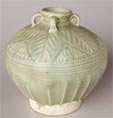 The Longquan
(1400) was loaded with similar celadons but of an
earlier date. The Longquan
(1400) was loaded with similar celadons but of an
earlier date.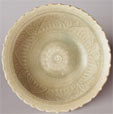 |
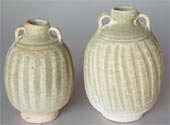 |




The Royal Nanhai ship carried celadon with exquisite incised decorations. This period (1460) seems to be the peak of its technique and craftsman ship
Antique Teapots and Other Yixing ware
|
Yixing is a large pottery complex in Jiangsu province, China, that despite its old tradition is not as well-known as other ceramic centres. One of the reasons for the limited awareness among antique lovers is its comparatively little exports. Tea lovers all over the world do however appreciate Yixing teapots and consider them the very best of teapots. These teapots are still made today although the 'old' granular clay, making the best of tea, was exhausted long ago. There are two distinct differences between ordinary pottery and Yixing wares. The first is the type of clay used. The second: most wares are made by hand and not on a potters wheel. Yixing 'purple' clay is if fact a mixure of the purple soil, the green soil (from the mountains of Yixing) and the red soil. The purple clay arrives from around Lake Tai and the mixture of the three different types of minerals is still a safely guarded secret. |
|
9.5 cm high yixing pot from the Desaru (1830) Wreck |
|
10.5 cm high yixing pot from Desaru(1830) wreck |

|
Granular clay make it less suitable for forming on a potters wheel.
Instead, the potter will flatten the clay by hand, cut to round and
rectangular shapes and join them in a mould. After setting in the mould,
the pot is individual shaped by beating it into its desired shape.
Other Yixing wares include garden pots, bowls and covered boxes. Some of them copying the famous Song-dynasty Jun ware. While the clay in these pots is not the famous purple clay, it is granular, porous and allows water to slowly penetrate. These pots too are made in moulds from a circular bottom piece joined with a flat rectangular side piece. |
6.5 cm high yixing pot from the Desaru (1830) Wreck
|
All Yixing teapots recovered from the Desaru shipwreck, are tentatively dated to 1830, are marked in the base with the potters name. This mark will sometimes show the name of the factory and include a Chinese poem, most frequently associated with mountains, spring water and the likes. The marks shown below represents some of the different markings on teapots from the Desaru shipwreck
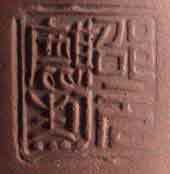
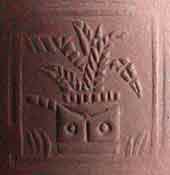
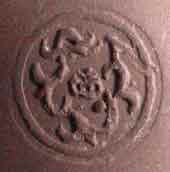
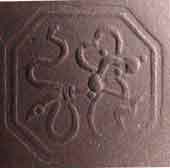
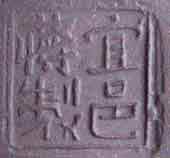

Antique Chinese Porcelain
("Blue and white" or "Underglaze blue")
|
Porcelain is the best known type of pottery. Porcelain is sometimes referred to as 'Blue and white' from its contrasting colour or 'Underglaze blue' from its blue cobalt oxide below the glaze. The reason Chinese porcelain becomes so famous could is probably because it is found in the Europeans and American's East India ships, trading with China from the 17th century. At that time, China had already exported blue and white porcelain to the Middle East and Southeast Asia for three centuries. Despite this great success in ceramic history, porcelain was not the reason the early European's were drawn to Asia. It was spices! The first Portuguese merchants to visit China eventually realized the value of the "white gold" and started importing limited quantities for the nobles of Europe. It was however first in 1603 that the Dutch East India Company (VOC) sent a load of porcelain to Amsterdam where it was sold for enormous profit. Following that Chinese blue and white porcelain became a much desired product in Europe and the United States which eventually interested antique collectors. China's earlier and traditional ceramics like the underglaze black decorated wares and celadon, is still not that well-known today. |

Chinese porcelain Ewer
from the early 16th century. Although its reign mark in the base indicate emperor Xuande (1425-1436) the ewer was made one century later |
|
Traditional Chinese Bowls |
During the early part of the Yuan dynasty (1280-1368), potters at
Jingdezhen, China, succeeded in decorating whitish local clay with blue
cobalt oxide under a clear glaze, overcoming earlier technical
difficulties relating to both the colors and the glaze. The date of this
major event in ceramic history is much debated, but it is believed that it
could have been as early as AD 1300.
Production of blue-and-white ceramics developed rapidly during the Ming dynasty (1368-1644), greatly influenced by the imperial court and its stringent requirements. Although 'imperial' kilns in the Jingdezhen area also made trade ware, those at Shantou (Swatow), Dehua and other parts of Fujian produced most of the exports for Southeast Asian markets. |
Underglaze Black decorated Wares
 Sukhothai flower motifs were popular in the Southeast Asian markets
|
Long before the Chinese made blue and white porcelain using cobalt, a black iron oxide was used to paint motifs below a clear permanent glaze, thus protecting the decorations for long times. This technique, used at Cizhou in northern China, developed independently from the celadon production in southern China. By the 14th century, the underglaze technique appeared in Sukhothai and Sisatchanalai in Thailand, and in Vietnam. At Sukhothai, production continued until the end of the 16th century. Indigenous underglaze motifs included stylised flowers and fish. Fish, and the chrysanthemum representing long life and happiness, were preferred at Sukhothai and Sisatchanalai. In Vietnam, a flower motif was common.
|
 Vietnamese bowls and Sukhothai plates were plentiful on the Turiang |
|
Sukhothai plate with similar flower mofifs as those in Vietnam. |
It is possible that the underglaze decoration technique (painting with oxides and then applying glaze) arrived in both Thailand and Vietnam with immigrating Chinese potters. The Turiang shipwreck (+/- 1370) is the first known case of similar Vietnamese and Thai underglaze decorated products being found together and clearly contemporary. Other underglaze decorated wares from Sukhothai were found on the Longquan, Xuande and Singtai shipwrecks. Underglaze painted ware of this period is rare. Collectors beware: modern Thailand produces many copies, often sold as genuine antiques
|
 Sukhothai and Vietnam used the shevron scroll to decorated the rim |